The Borcher’s Drake represents a number of different flies that hatch in the region, not just one particular mayfly making it not only versitle, but also effective. You will want to tie this pattern in various sizes to imitate many of our early mayfly patterns which include but are not limited to: Hendricksons, Mahoganies, March Browns, Black Quills, Sulphurs & Isonychias. This list of mayflies vary in color however this pattern does a good job of imitating the spinner stage of the aforementioned mayflies which all tend to be dark in color, often a mahogany/rusty color.
The original drake pattern was tied with condor feather and was more of a traditional Cat-Skill style hackle with up-right wings. The recipe and directions for the drake pattern below uses easy to find materials and is tied in a parachute style.
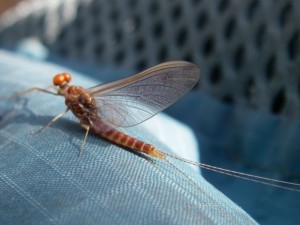
Parachutes are my favorite style of dry flies because they sit low in the water, have an excellent silhouette and provide an easy to see post. I also like how parachutes tend to land properly on the water and are – in my opinion – much easier to tie than the original.
Originally tied by Ernie Borcher of the Grayling area in the mid 1900’s, the drake pattern has been recognized as one of a few that should be in every angler’s fly box when fishing Michigan rivers in May and June. It’s easy to tie, effective to fish and a staple in my fly box. Not into fly tying? The Northern Angler in Traverse City stocks this custom-tied drake pattern in a variety of sizes.
Borcher’s Drake Recipe
Hook: TMC 100 12 – 16
Thread: Uni-8/0 Camel
Tail: Moose Body
Body: Cinnamon Tip Turkey Tail
Rib: x-small copper wire
Post: Hi-Vis or Para-Post
Hackle: Grizzly
Abdomen: Brown Dry Fly Dubbing
Tying Instructions
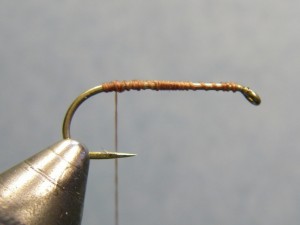 Step 1. Wrap thread base from behind eye to above barb.
Step 1. Wrap thread base from behind eye to above barb.
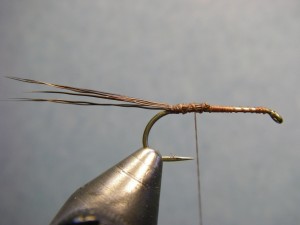 Step 2. Stack/even 4-5 moose body hairs and tie in so the
Step 2. Stack/even 4-5 moose body hairs and tie in so the
pointed ends extend 1 ½ times the length of the hook shank.
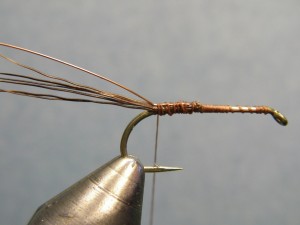 Step 3. Tie in rib/copper wire extending backward.
Step 3. Tie in rib/copper wire extending backward.
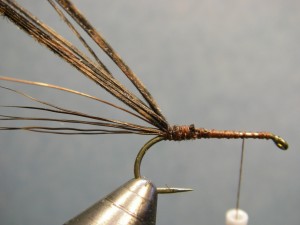 Step 4. Take a clump of turkey tail and remove/pull it from the stem. Tie in by the tips at the rear
Step 4. Take a clump of turkey tail and remove/pull it from the stem. Tie in by the tips at the rear
of the hook where the rib is tied in. (Approximately ¼ -inch of fibers for a size 12)
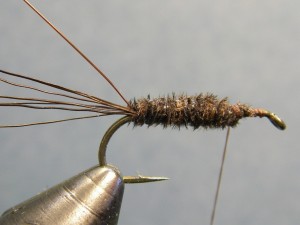 Step 5. Tightly wrap the turkey forward slightly building a tapered body that gets thicker as
Step 5. Tightly wrap the turkey forward slightly building a tapered body that gets thicker as
you approach the eye. Stop wrapping and tie off 1/3rd of the way back from the eye.
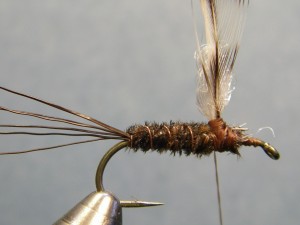 Step 6. Wrap the ribbing through the body in the opposite direction that you did the body material for
Step 6. Wrap the ribbing through the body in the opposite direction that you did the body material for
reinforcement. Then tie in your post material where the body ends. I like to make
a small loop out of the synthetic post material to keep a wing like profile.
 Step 7. Tie in a hackle feather along the base and up the post.
Step 7. Tie in a hackle feather along the base and up the post.
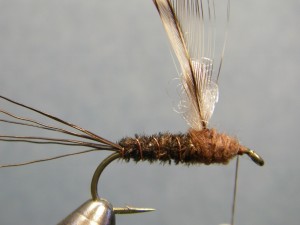 Step 8. Dub a thorax that is slightly larger than the body. Most mayfly spinners
Step 8. Dub a thorax that is slightly larger than the body. Most mayfly spinners
have a thin abdomen and a large thorax – keep that in mind when dubbing .
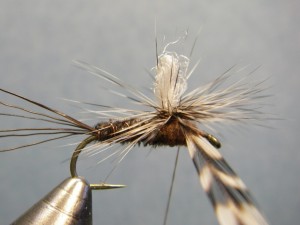 Step 9. Wrap a generous parachute wing with the hackle feather and tie off.
Step 9. Wrap a generous parachute wing with the hackle feather and tie off.
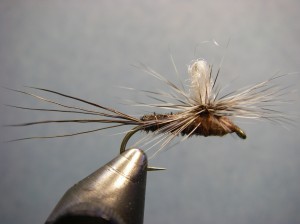 Step 10. Whip finish being careful not to trap any of the hackle in the process.
Step 10. Whip finish being careful not to trap any of the hackle in the process.
